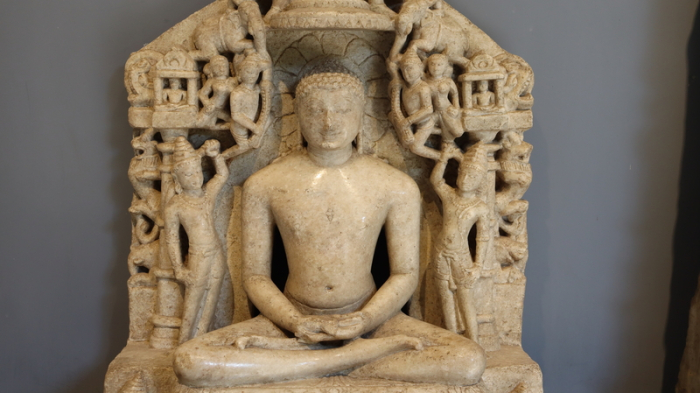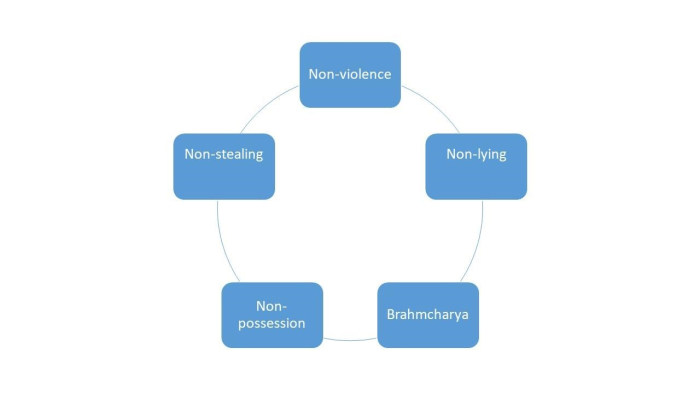

Jainism originated from the old Sanskrit word ‘Ji’, which means to conquer. Jain monks believe that they have to concur earthly passion and desires to achieve enlightenment. Individuals who gain enlightenment came to be known as “Jina”. Jainism originated in Gangetic pains in 500-600BCE. It was one of the multiple religious sects that arose at that time.
Jainism believes in the philosophy of non-violence and universal benevolence. Jains are strictly vegetarian and live a life minimalistic life. Like the Hindu religion, Jainism also talks about reincarnation. Which means the circle of life and death, and the soul lives forever. The main aim of Jains is to escape the cycle of death and birth and achieve enlightenment.

The exact origin of Jainism is very hard to determine. The first Tirthankara of Jainism is Rishabhnath, but it gained publicity and become a full flagged religion in the time of Mahavir. Vardhman Mahavir was the 24th Tirthankara of Jains, he was a contemporary of Gautam Buddha. Same as Buddha the was also born in the Kshatriya caste. He was born in a village near Vaishali, Bihar. His father Siddhartha was the head of the Kshatriya clan and his mother Trishla was the sister of Lichhivi King Chetak.
Mahavir abandoned the family at the age of 30 in search of the truth. He renounced all kinds of passion and desire and for 12 years he took the path of solitary, meditation and become an ascetic. After the hardship of 12 years, he attained Kaivalya, which means omniscience. He has won over happiness and misery. For the next 30 years, he went from place to place with his followers and propagate the Jain religion and preached the teachings.

Ancient Indian society was divided into four Varnas, which later came to be known as the Caste. The four Varnas were: Brahaman, Kshatriya, Vaishya and Sudra. The society was in hierarchical order and Brahmans were the most dominant and powerful Varna. They were allotted the functions of priests. The Kshatriyas were the second-highest varna and they were a warrior class. The Vaishyas allotted themselves to business and they were merchants. The last varna in this hierarchy was the Sudras, they were manual labourers and they were meant to serve the adobe three varnas.
One of the main causes was the reaction of Kshatriya varna against Brhamaical dominance.
Other varnas were also dissatisfied with the growing ritualistic domination of Brahman.
Corruption in existing religions became another factor in the origin of the new religion.
The Language was also a major factor in people's dissatisfaction, Brahmans used the Sanskrit language which was not known to the local mass.
Jainism believes in the philosophy of Ahimsa, which is non-violence. They believe in the purification of the soul and that is the only way to attain moksha or eternal liberation.
There are five doctrines of Jainism −
Non-violence.
Do not lie.
Do not steal.
Do not stock unnecessarily.
Observe brahmacharya.
These five teachings are to be followed by every Jain. Mahavira told his followers to even renounce the clothes and lead a strict life.
There are three jewels or Triratna of Jainism through which eternal liberation can be attained. These are −
Through the right knowledge.
Through right faith.
Through right action.

Jainism can be explained in nine fundamental principles, these nine principles are summed up in four stages −
The first stage talks about, what the universe is made up of −
Jiva is the living soul of the universe.
Ajiva is the non-living material in the world.
The second stage describes the behaviours in the universe.
Punya, which is a good deed.
Papa, which is a bad deed.
The third stage describes karma in the universe.
Asrava; describes the inflow of karma into the soul, through yoga and meditation.
Samvara; is the stoppage of the inflow of material karma into the soul.
Bandha; which simply means the bondage of karma and the soul.
Nirjara; is the last stage before attaining eternal liberation. Nirjara is the renunciation of karma itself. The one who is to attain moksha must renounce his karma and should stop himself from gathering new karma.
The final stage is,
Complete liberation of the soul and attaining moksha. The break from the cycle of birth and death.
From these fundamental principles, Jainism can be understood.
Approx 200 years after the death of Mahavir, a great famine engulfed north India. The great famine lasted for 12 years. People started to migrate in order to search for better conditions. Many Jainas along with other people migrated and went to south India. There are multiple pieces of evidence, which show the spread of Jainism in Karnataka during this period.
The Jainas who migrated claimed that they fully adhered to the principle and teaching of Jainism and they never broke any vows. They discarded their clothes and came to be known as Digambaras.
After the famine ended, Digambaras came back to Magadha. They claimed distortion in local Jainas, and those Jainas who never left Magadha had violated rules and their Vows. they wore white clothes and became known as Shvetambaras. Jainism was divided into two sects, Shveytambaras and Digambaras.
There are no priests in Jainism. They only have monks and nuns.
Jainism did not oppose the varna system like Buddhism.
Initially, Jainism didn't practice idol worshipping or any kind of image worshipping.
Jainism popularised the use Prakrit language.
Parasnath hills and Girnar hills are the ancient pilgrimages for Jainas.
Jainism refutes the practice of agriculture because in this practice organisms living inside the soil could die.
Jains always keep a piece of cloth in front of their mouth, to block the accidental inhalation of organisms.
Jainism is a peaceful religion and its core value is non-violence. Jainas believe in the teaching of their enlightened beings who are called Tirthankaras. The first Tirthankara is Rishavdev. Vardhman Mahavir is considered the most important Tirthankara of Jainism who made it a full-fledged religion. Mahavir was the 24th Tirthankara and he is credited with the popularisation of this religion.
Q1. under whose leadership did Jainas migrate to South India?
Ans. Under the leadership of Bhadrabahu Jainas left for South India, and later they came to be known as Digambaras.
Q2. what are Agamas?
Ans. Agamas are the text containing the teaching of Mahavira.
Q3. How did Jainism spread in India?
Ans. Jainism divided into sects and they all moved across India, to popularise their religion. Jaina kings built many caves and pilgrimage sites for Jainas. Local mass also adopted Jainism because it didn't had any caste hierarchy.
Q4. What is the core belief of Jainism?
Ans. core beliefs of Jainas are non-violence and gaining eternal liberation through following strict rules.
Q5. What was the main reason for fewer followers of Jainism?
Ans. There were several factors for fewer followers in Jainism, the major factor was the harsh and strict rules that needed to be fulfilled. Example- vegetarianism, renunciation of clothes, family and all earthly desires. Jainism also suggests avoiding agriculture, because it may harm organisms living underground.